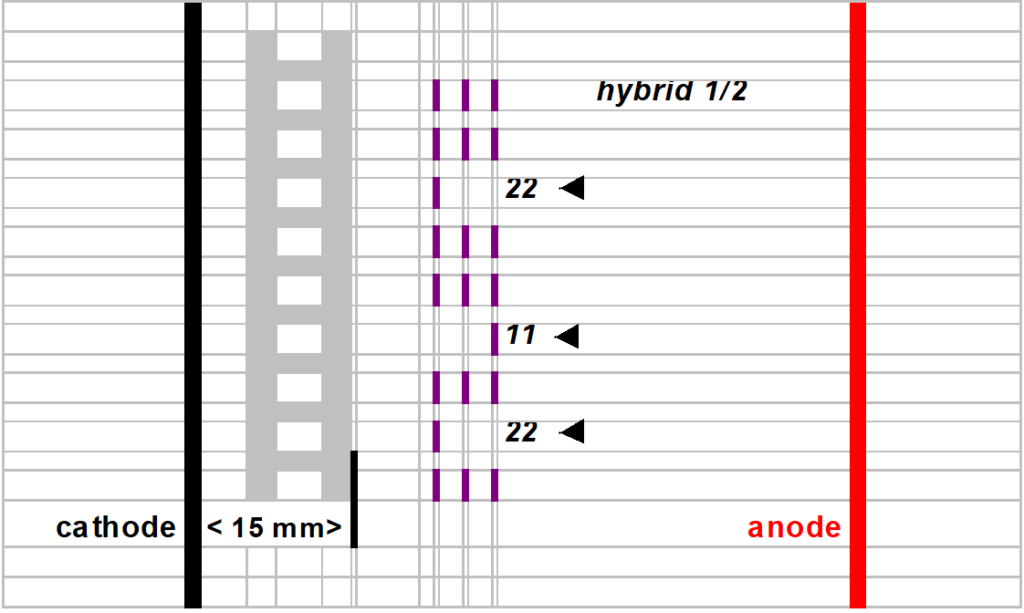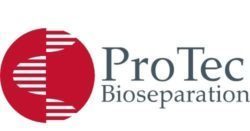Squash
ACO – (Aconidase)
16 % v/v glycerol
Bring 200 grams (= 160 ml) of glycerol (q.c.w. Sigma G-7757) and 800 ml distilled water in a beaker. Mix well and bring to a final volume of 1000 ml with distilled water. Store in the refrigerator.
Sepalyte pH 3-10 (Cat.No. 42008 ProTec Bioseparation)
Ready to hand Sepalyte solutions. Store in refrigerator
Sepalyte pH 3-6 (Cat.No. 42006 ProTec Bioseparation)
Ready to hand Sepalyte solutions. Store in refrigerator
Acrylamide/ bis acrylamide 29 : 1 solution
Ready to hand acrylamide solution (q.c.w. Sigma A-3574). Store in refrigerator.
0.1N Sodium hydroxide
4.0 g sodium hydroxide (q.c.w. Sigma S-8045) in 1000 ml distilled water. Add a trace (tip of a small spatula) of sodium azide (q.c.w. Sigma S-8032). Store at room temperature
0,1% w/v riboflavin
0.05 g riboflavin (q.c.w. Sigma R-0508) in 50 ml 0.1 N sodium hydroxide.
Store in the refrigerator for up to 2 weeks.
10% w/v ammonium persulfate
0.5 g ammonium persulfate (q.c.w. Sigma A- 3678) in 5.0 ml distilled water.
Store in refrigerator for one week
0.1N Sodium hydroxide
4.0 g sodium hydroxide (q.c.w. Sigma S-8045) in 1000 ml distilled water. Add a trace (tip of a small spatula) of sodium azide (q.c.w. Sigma S-8032). Store at room temperature.
4 N Sodium hydroxide
16.0 g sodium hydroxide (q.c.w. Sigma S-8045) in 100 ml distilled water. Store in the refrigerator.
0.25 M Glycine- NaOH buffer pH 8.6
Bring 9.40-g glycine (q.c.w. Sigma G- 7126) in ± 400 ml distilled water. Stir until fully dissolved. Adjust the pH to 8.6 with a 4 N NaOH solution (± 2.2 ml). Bring to a final volume of 500 ml with distilled water. Store in a refrigerator.
ACO extraction solution
Add 2.0 g sucrose (q.c.w. Sigma S-8501) to 20 ml glycine/NaOH buffer pH 8.6. Mix well before use! Add a trace (tip of a small spatula) of Orange G (q.c.w. Sigma O-1625). Do not store.
0.1 M Tris-HCl pH 8.0
Bring 24.2 g Tris (q.c.w. Sigma T-8524) and 0.8 g EDTA (q.c.w. Sigma E-5134) in 1600 ml distilled water. Stir until fully dissolved. Adjust the pH to 8.0 with concentrated HCl (q.c.w. BDH 28507). Bring to a final volume of 2000 ml with distilled water. Add a trace (tip of a small spatula) of sodium azide (q.c.w. Sigma S-8032). Store at room temperature.
4 M magnesium chloride
Bring 203-g magnesium chloride hexahydrate (q.c.w. Sigma M-0250) and 150 ml distilled water in a beaker. Stir until fully dissolved and bring to a final volume of 250 ml. Store at room temperature.
0.005 M Glycine-BSA buffer
Bring 0.20-g glycine (q.c.w. Sigma G- 7126) and 0.5 g bovine serum albumin bovine (q.c.w. Sigma B-4287) in ± 400 ml distilled water. Stir until fully dissolved. Adjust the pH to 8.0 with a 4 N NaOH solution. Bring to a final volume of 500 ml with distilled water. Store in a refrigerator.
2 % v/v Acetic acid solution
Bring 20 ml of acetic acid 100%(q.c.w. BDH 27013) in 1000 ml distilled water. Store at room temperature.
TEMED
Ready to use TEMED Sigma ( T-9281).
Gel preparation
9.5 ml 16 % glycerol
2.0 ml Acrylamide/bis 29:1solution
0.5 ml Sepalyte pH 3-6
0.5 ml Sepalyte pH 3-10
0.065 ml 0.1 % w/v riboflavin
0.012 ml TEMED
0.035 ml 10% ammonium persulfate
Add the above reagents and swirl to mix. Pour the gel according to the flap technique and allow polymerizing for at least 4 hours under a light. Store the gels in a sealed bag in the refrigerator for up to 2 weeks.
Sample preparation
Single cotyledon/first leaf punches (using the cork borer # 3, diameter 7 mm ) from soil germinated seeds (6-8 days old) are submerged in water. The cotyledons absorb water. Place the wet cotyledons into a 96 well microplate. Flatten the punch-outs onto the bottom of the well. Freeze for at least 2 hours or better overnight. After the freezing step, the frozen leaf punches are homogenized using the Terminator. The punch-outs should be homogenized while they are still frozen. Crush for two minutes without extraction fluid. After this, the Terminator is taken out of the microplate and put aside. Add now to each well 100 ml of ACO extraction solution. Bring the Terminator back in the microplate in such a way that the pestles are in the same wells before the Terminator was removed. Continue to crush for 1 minute and centrifuge for 10 minutes at 3000 rpm. at 10° C (or at room temperature).
Electrophoresis
Turn the cooling supply on and set at a temperature of ± 15°C. Remove the gel from the glass plates. Clean the back of the gel with methanol/ethanol. Place the gel onto the cooling plate with several ml of water. The gel can be divided into three parts. Space the electrodes evenly across the gel, alternating cathode (black electrode) and anode (red electrode), and then place directly onto the gel.
Power settings are for one gel (double the mA and Watts when running two gels).
Prefocusing
Run 1: 600 V–60 mA–20 W–300 V/h
Sample application
After the prefocusing step, the 52 templates are positioned ± 15 mm from the cathode (black electrode). See cartoon image section “gel interpretation 9.1.6 “ Each sample well is filled with 20 ml of supernatant.
Focusing
Run 2: 300 V–20 mA–15 W–100 V/h
Run 3: 1500 V–20 mA–15 W–2000 V/h
After the gel has finished running, remove the gel from the cooling plate and place into an appropriate staining tray.
ACO staining
125 ml 0.1 M Tris- HCl pH 8.0
0.20 ml 4 M MgCl2 solution
0.40 g cis-aconitic acid (q.c.w.Sigma A-3412)
0.05 g NADP (q.c.w.Sigma N-3886)
0.05 g MTT (q.c.w. Sigma M-2128)
0.01 g PMS (q.c.w. Sigma P-9625) (tip of the small spatula)
0.04 g isocitric dehydrogenase (q.c.w.Sigma I-1877), dissolve in 1 ml of
0.005 M glycine BSA buffer just before staining.
Heat up the Tris-HCl solution to ± 37° C. Add the reagents together and mix until fully dissolved and stain the gel at room temperature until the bands can be clearly visualized. Remove the stain and destain the gel in a 2 % glacial acetic acid solution for about 10 minutes. Finally, remove the water/acetic acid mixture and rinse with distilled water. The gel can then be air-dried.
Gel interpretation
No international enzyme classification is used.
The nearest band of interest from the anode is genotyped “11”
The farthest band of interest from the anode is genotyped “ 22”
The hybrid is genotyped “1/2” in case that the female is 11 and the male 22.
The hybrid is genotyped “2/1” in case that the female is 22 and the male 11.

ProTec Bioseparation (Protein Electrophoresis)

